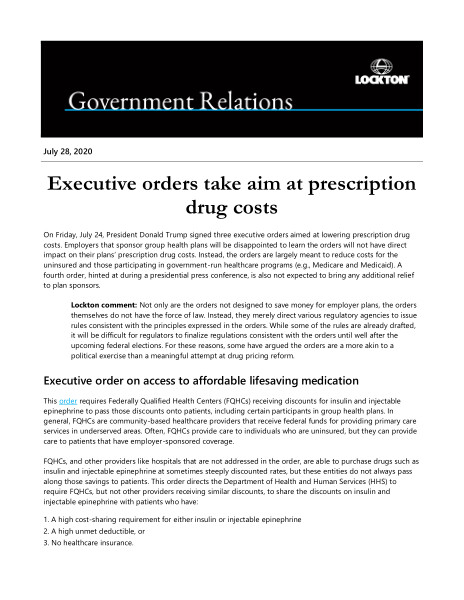July 28, 2020
On Friday, July 24, President Donald Trump signed three executive orders aimed at lowering prescription drug costs. Employers that sponsor group health plans will be disappointed to learn the orders will not have direct impact on their plans’ prescription drug costs. Instead, the orders are largely meant to reduce costs for the uninsured and those participating in government-run healthcare programs (e.g., Medicare and Medicaid). A fourth order, hinted at during a presidential press conference, is also not expected to bring any additional relief to plan sponsors.
Lockton comment: Not only are the orders not designed to save money for employer plans, the orders themselves do not have the force of law. Instead, they merely direct various regulatory agencies to issue rules consistent with the principles expressed in the orders. While some of the rules are already drafted, it will be difficult for regulators to finalize regulations consistent with the orders until well after the upcoming federal elections. For these reasons, some have argued the orders are a more akin to a political exercise than a meaningful attempt at drug pricing reform.
Executive order on access to affordable lifesaving medication
This order (opens a new window) requires Federally Qualified Health Centers (FQHCs) receiving discounts for insulin and injectable epinephrine to pass those discounts onto patients, including certain participants in group health plans. In general, FQHCs are community-based healthcare providers that receive federal funds for providing primary care services in underserved areas. Often, FQHCs provide care to individuals who are uninsured, but they can provide care to patients that have employer-sponsored coverage.
FQHCs, and other providers like hospitals that are not addressed in the order, are able to purchase drugs such as insulin and injectable epinephrine at sometimes steeply discounted rates, but these entities do not always pass along those savings to patients. This order directs the Department of Health and Human Services (HHS) to require FQHCs, but not other providers receiving similar discounts, to share the discounts on insulin and injectable epinephrine with patients who have:
1. A high cost-sharing requirement for either insulin or injectable epinephrine
2. A high unmet deductible, or
3. No healthcare insurance.
The practicalities of how this pass-through requirement will play out are left to the discretion of HHS. Many questions remain. For example, what counts as a high cost-sharing requirement or high deductible and who actually qualifies for the savings? How will an FQHC coordinate with a group health plan to determine whether the cost-sharing or deductible threshold is met? If the participant is in a group health plan, can the FQHC bill the plan a higher amount than what they pay for the drug plus a permitted administrative fee?
Executive order on increasing drug importation to lower prices for American patients
It is no secret that individuals in other countries often pay less for various drugs, in part because of strict government-imposed drug pricing laws. Some state and tribal government officials have asked the federal government for permission to import drugs, or in some cases reimport drugs manufactured in the United States and shipped to other countries, at lower prices than are available in the U.S. Patient advocates have also pushed for reforms of rules limiting the type and quantity of drugs individuals can bring to the U.S. from another country.
This order (opens a new window) directs HHS to adopt three significant rule changes related to drug importation:
1. Finalize the rulemaking begun last December (opens a new window) to permit importation of drugs from Canada.
Lockton comment: This rule is far from simple. The rule lays out several significant hurdles to importation that must be met such as labeling and facility inspection requirements. Further, it does not allow importation of specialty drugs, IV products, or controlled substances.
2. Authorize the reimportation of insulin made in the United States, but only if HHS finds that it is needed for emergency purposes.
3. Provide a broader pathway through an FDA program for individuals’ personal drug importation.
Lockton comment: It is easy to see how these programs could be expanded for group health plan sponsors if successful. But that’s the rub. Other countries, especially Canada, have been vocal about taking measures to protect their drug supplies from being exported to the U.S.
Executive order on lowering prices for patients by eliminating kickbacks to middlemen
This order (opens a new window)requires rebates paid by drug manufacturers to pharmacy benefit managers (PBMs) administering Medicare Part D plans to pass those rebates on to patients at the point of sale. Currently, some Part D plans will use all drug rebates to reduce plan premiums, which means the patient triggering the rebate could pay more for the drug than what the plan actually paid. This order requires Medicare Part D plans to share the rebate with the patient who triggers it.
Lockton comment: HHS has already proposed rules that accomplish this same purpose. Stakeholders responding to these rules were sharply divided over the proposal. Ultimately, HHS put the rules on hold because of concern they would cause premiums to rise. The order recognizes this conundrum (i.e., passing along the rebates to a few could raise premiums for the many) and directs HHS to implement a pass-through rule only if “the action is not projected to increase [f]ederal spending, Medicare beneficiary premiums, or patients’ total out-of-pocket costs.”
Forthcoming executive order to ensure the U.S. pays the lowest price available on Medicare Part B drugs
The president’s comments and press documents indicate that a forthcoming order will change the way Medicare Part B pays for drugs. Medicare Part B covers doctor visits, lab tests, diagnostic screenings, medical equipment, ambulance transportation and other outpatient services. Participants in Part B, unlike Part A (which covers hospitalization), shoulder some of the costs. Under current rules, Medicare pays providers the “average sales price” of the drug, plus 6%. The expected order would reduce the payment based on an index of what other countries pay.
The specifics of this proposal remain uncertain. We initially expected to learn more after this week, when the president was scheduled to meet with pharmaceutical manufacturers. That meeting was scrapped when executives declined the White House invitation in protest of the other orders.
Scott Behrens, J.D., Director, Government Relations
Sarah Martin, Vice President, Pharmacy Analytics
 Download alert (opens a new window)Not legal advice: Nothing in this alert should be construed as legal advice. Lockton may not be considered your legal counsel, and communications with Lockton's Government Relations group are not privileged under the attorney-client privilege.
Download alert (opens a new window)Not legal advice: Nothing in this alert should be construed as legal advice. Lockton may not be considered your legal counsel, and communications with Lockton's Government Relations group are not privileged under the attorney-client privilege.


